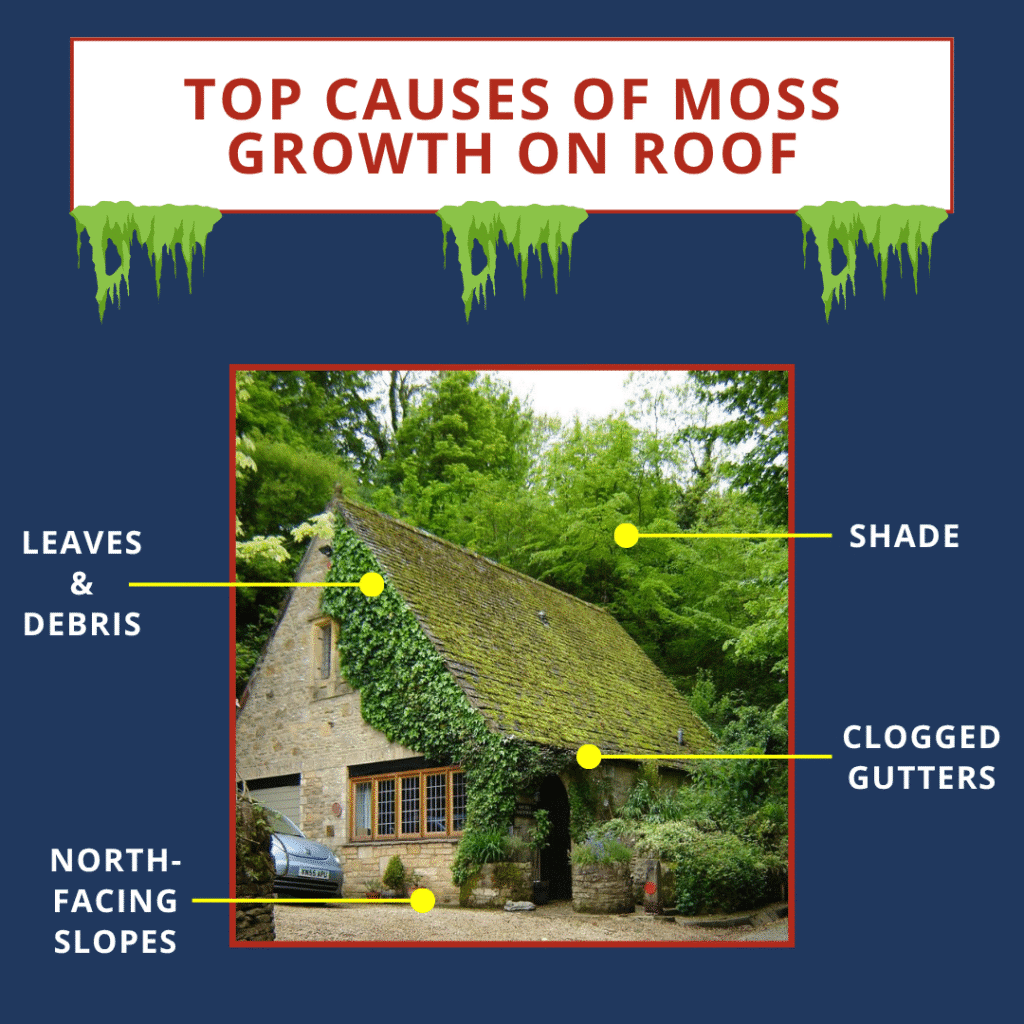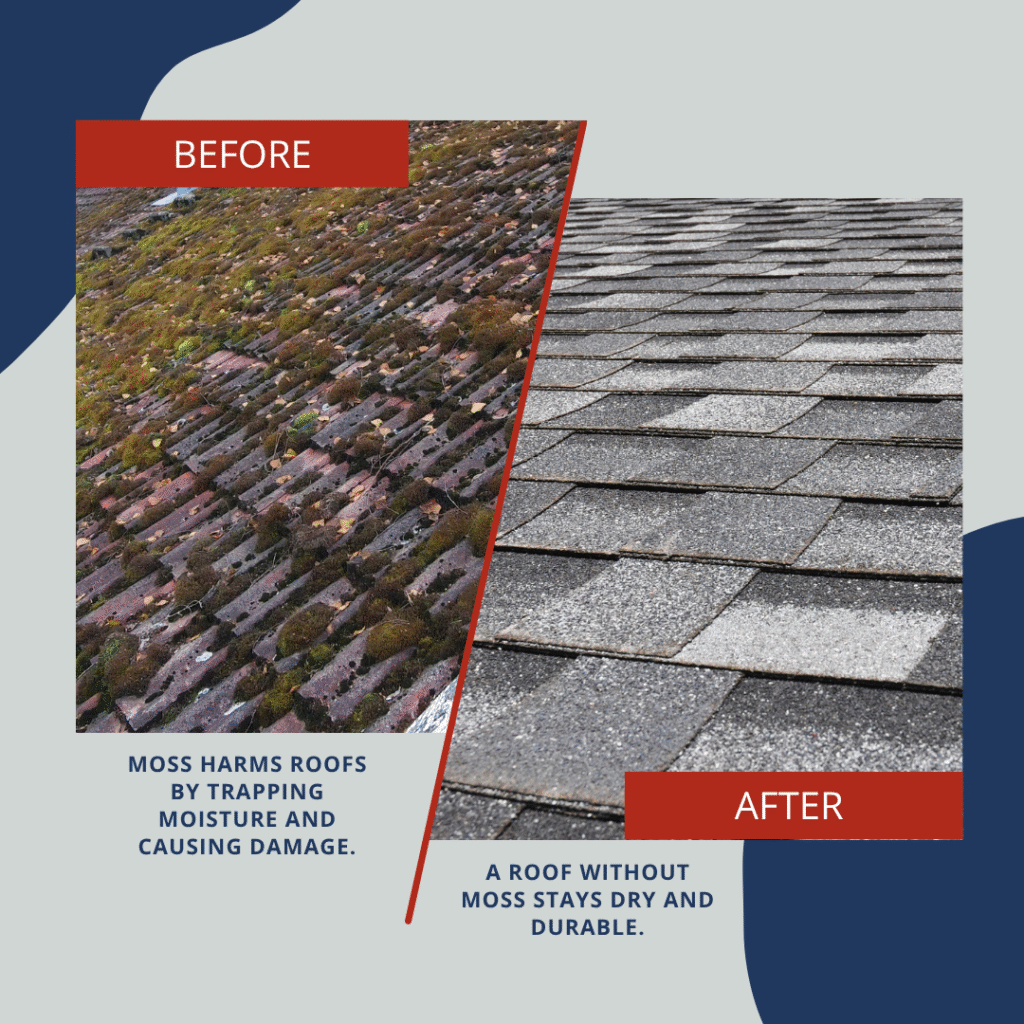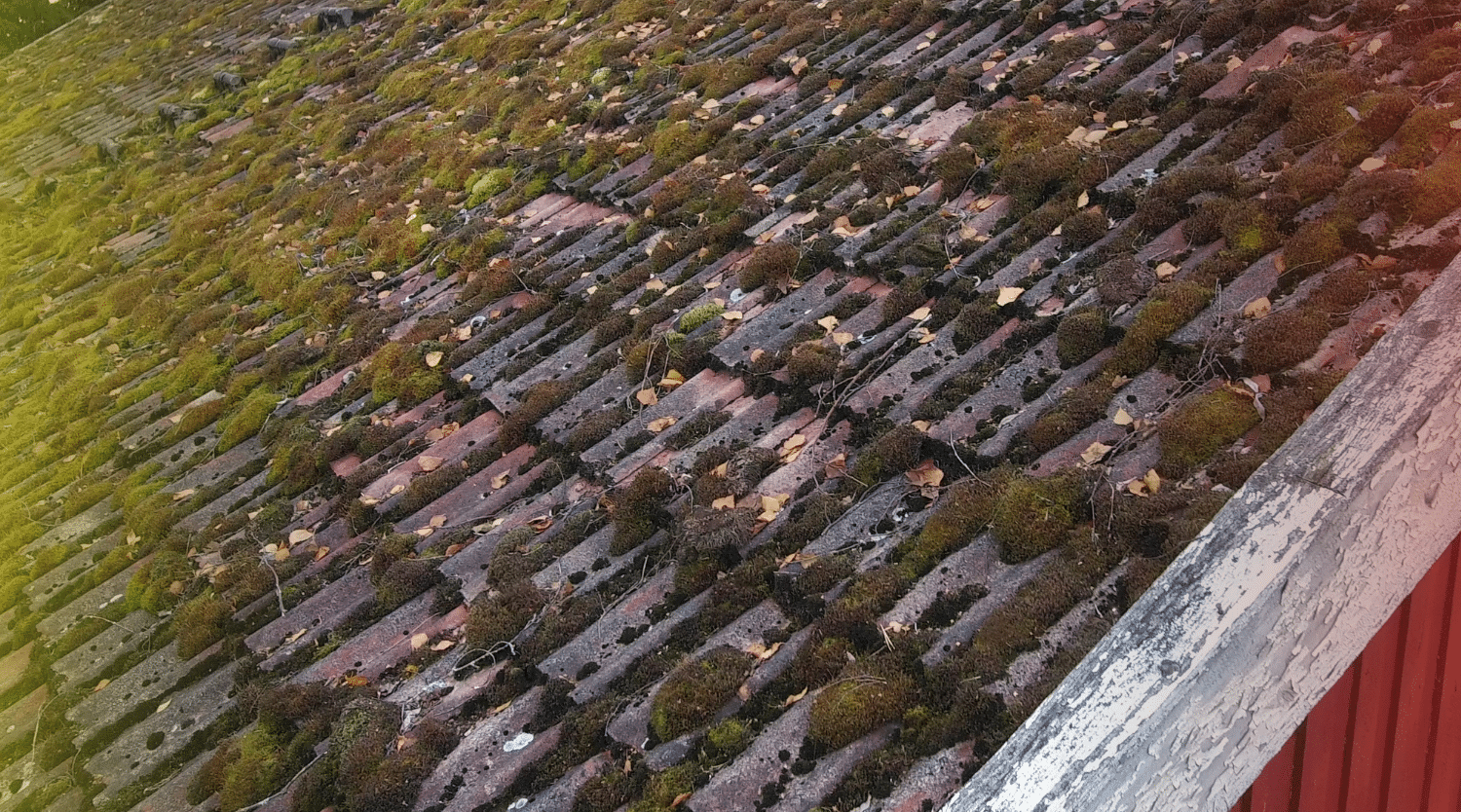If you want your home to look its best, learning how to remove moss from roof surfaces safely is a smart place to start. Not only does moss removal protect your home’s structure, but it also instantly improves your curb appeal.
Moss might look soft and harmless, but when it starts growing on your roof, it becomes a real problem. Those thick green patches don’t just make your roof look old. They can trap moisture, loosen shingles, and shorten your roof’s lifespan. Over time, that can lead to leaks, wood rot, and expensive repairs.
In this post, we’ll explain why moss forms, how it damages your roof, and how to clean and prevent it effectively.
Why Moss on Roofs Hurts Curb Appeal
Your roof makes up a large portion of your home’s visible exterior. When moss starts spreading, it gives the impression that your home is neglected. Even if the rest of your property looks great, a moss-covered roof can drag down the entire appearance.
Curb appeal is especially important if you plan to sell your home. First impressions matter, and buyers often notice the roof right away.
A roof that looks clean and cared for suggests the rest of the property is in good condition, too. Removing moss not only enhances your home’s beauty but also adds perceived value.
Homeowners who schedule regular roof inspections often enjoy fewer maintenance surprises and better overall property value. That’s why companies like P.I. Home Inspection Services emphasize roof condition as part of a complete home inspection.

What Causes Moss to Grow on Roofs
Moss spores are always in the air, but they only grow when conditions are right. Here are the most common causes of moss on your roof:
- Shade and moisture: Roofs shaded by trees or tall buildings dry more slowly after rain. This constant dampness creates the perfect place for moss to take hold.
- Clogged gutters: Gutters filled with leaves or debris can overflow, keeping water close to the roofline and encouraging moss growth.
- Fallen leaves and debris: Organic material traps moisture on the roof, allowing moss to spread faster.
- North-facing slopes: Roofs that get little sunlight stay cooler and damper, creating ideal moss conditions.
When left unchecked, these factors combine to create a layer of moss that can become thick and spongy. That’s why prevention and regular maintenance are key to keeping your roof moss-free.
How Moss Can Damage Your Roof
Many homeowners don’t realize how destructive moss can be. It doesn’t just sit on top of your roof; it works its way between shingles and holds moisture against the surface. Over time, this can lead to several major issues:
- Shingle lifting: As moss grows, it pushes shingles upward, breaking their seal and allowing water underneath.
- Wood rot: Moisture trapped beneath moss can soak into the roof decking and lead to rot.
- Leaks: Once water seeps under shingles, it can enter your attic and eventually cause interior ceiling stains or mold.
- Freeze-thaw damage: In colder weather, trapped water freezes and expands, causing cracks and further lifting of shingles.
Moss also hides small cracks or missing shingles, making roof problems harder to spot. During an inspection, professionals often find that moss-covered roofs have more hidden damage than clean ones.
How to Remove Moss from the Roof Safely
Removing moss the wrong way can do more harm than good. Scraping too hard or using high-pressure washing can tear off protective granules and damage shingles. Here’s the best way to remove moss carefully and effectively.
Start with a Roof Inspection
Before cleaning, check your roof for signs of wear or damage. If shingles are cracked, curled, or loose, cleaning could make things worse. A professional inspection from P.I. Home Inspection Services ensures your roof is safe to walk on and helps you identify areas that need repair.
A good inspection can also reveal moisture damage or structural issues that moss might be hiding. Starting with this step can save you time, money, and frustration later.
Gentle Cleaning Methods That Work
- Clear the roof: Use a broom or leaf blower to remove twigs and leaves.
- Dampen the moss: Lightly wet the moss with water to loosen it. Avoid soaking the roof, as too much water can make it slippery.
- Scrub softly: Using a soft-bristle brush, gently brush downward along the slope. Never scrub side to side or upward, as this can lift shingles.
- Rinse gently: Use a garden hose with low pressure to rinse away loose moss and debris.
- Allow it to dry: Let the roof dry naturally. Avoid walking on wet surfaces.
Safety tip: Use a stable ladder, wear rubber-soled shoes, and have a spotter nearby. Never lean over the edge of your roof. If your roof is steep, slippery, or tall, hiring a professional is the safest choice.
DIY vs. Professional Moss Removal
DIY moss removal can work for light buildup, but for heavier growth, professional cleaning is safer and more effective. Professionals use roof-safe cleaning agents that kill moss without harming shingles or the environment. They can also check for damage that homeowners often miss.
If moss returns quickly after cleaning, it may be due to excess shade or poor drainage. A professional can help identify the underlying cause and recommend long-term prevention methods.
The Best Products to Remove Moss from the Roof
Not all moss removers are the same. Some are gentle and eco-friendly, while others are chemical-based for faster results. Choose the option that fits your home and roof type.
| Type | Example | How It Works | Best For |
| Natural | Baking soda or vinegar | Raises or lowers the pH to make the moss die naturally | Light moss patches |
| Chemical | Zinc sulfate-based moss killers | Kills moss quickly and prevents regrowth for months | Heavy moss buildup |
| Eco-friendly | Biodegradable roof cleaners | Break down moss safely without harming plants or pets | Regular maintenance |
If you prefer a DIY approach, you can mix baking soda and water in a 3:1 ratio and apply it using a garden sprayer. Let it sit for 15–20 minutes before rinsing gently.
Important tip: Avoid using bleach or ammonia mixtures. These can discolor your roof, damage nearby plants, and corrode gutters.
How to Prevent Moss from Coming Back
Once you’ve removed moss, keeping it away requires consistent maintenance. Here’s how to prevent regrowth and maintain your roof’s appearance:
- Trim overhanging branches: More sunlight helps your roof dry faster after rain.
- Clean gutters often: Clear gutters keep water from pooling near shingles.
- Install zinc or copper strips: Rainwater washing over these metals releases ions that stop moss from growing.
- Sweep off debris regularly: Use a broom or leaf blower to remove leaves that hold moisture.
- Schedule annual roof inspections: Early detection prevents moss from becoming a long-term issue.
Combining these simple actions will help your roof stay cleaner longer and reduce maintenance costs.
How Moss Affects Home Inspections
During a home inspection, moss growth can raise red flags. Inspectors view moss as a sign of trapped moisture and possible roof decay. Here’s what they often look for:
- Leaks or moisture intrusion: Moss often indicates water is seeping beneath shingles.
- Rotting or soft decking: Prolonged dampness can cause wood to weaken.
- Ventilation issues: A poorly ventilated attic can keep the roof damp, speeding moss growth.
- Damage hidden by moss: Moss can cover cracked shingles, missing granules, or other roof concerns.
For buyers, moss may raise questions about long-term roof maintenance. For sellers, removing moss before listing can make a strong first impression and help avoid costly repairs during negotiations.

Boosting Curb Appeal After Moss Removal
Once moss is gone, your home immediately looks cleaner and brighter. But don’t stop there. A few extra steps can make your exterior stand out:
- Clean gutters and downspouts: Prevent water stains and overflowing debris.
- Pressure wash walkways and driveways: Clean concrete adds polish to your property.
- Touch-up paint: Repainting trim or shutters gives your home a fresh finish.
- Refresh landscaping: Add mulch, flowers, or potted plants for color contrast.
- Check exterior lighting: Bright lighting highlights your home’s clean new look at night.
These updates complement your clean roof and help you maintain that fresh, well-cared-for appearance.
Related Questions
How long does it take for moss to damage a roof?
Moss can begin damaging the exterior of the roof and shingles in as little as one year if not addressed, especially in shaded or damp climates.
What’s the best season to remove moss from the roof?
Late spring and early fall are ideal. The weather is mild, and the roof is usually dry enough to work safely and avoid damage.
Can moss cause roof leaks?
Yes. Moss traps water that can seep through shingles, leading to leaks and ceiling stains.
Does removing moss increase home value?
It can. A clean roof improves curb appeal, signals good maintenance, and can make a home easier to sell.
When to Call a Professional
If moss covers large areas of your roof, it’s safer and more effective to call a professional. P.I. Home Inspection Services provides thorough roof evaluations that help you understand your roof’s condition and what steps to take next.
Professionals use specialized tools and cleaning agents that eliminate moss without harming shingles. They also check for underlying problems, such as leaks or damaged flashing, which can worsen if ignored.
Even if you prefer to handle cleaning yourself, it’s smart to schedule an inspection afterward to ensure the roof is still in good shape.
Routine professional inspections also provide valuable records for insurance claims or resale documentation.
Conclusion
Learning how to remove moss from roof surfaces is one of the best things you can do for your home’s curb appeal and longevity.
Moss removal prevents structural damage, protects your investment, and makes your home look fresh and inviting.
When you stay consistent with maintenance and inspections, your roof will last longer and your property will maintain its value.
If you’re ready to take care of your roof the right way, contact P.I. Home Inspection Services today to schedule a professional roof or home inspection. Protect your home and keep it looking beautiful for years to come.

